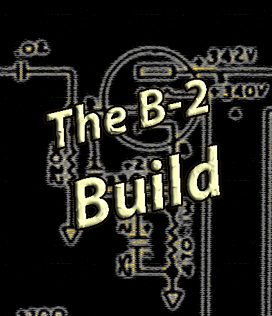the B-2 Board

warm round 6v6 tone without the 6v6 hassles or expensive 6v6 tube


If you remember the classic Fender Champ, you might have noticed that it used a 6V6 power tube. Although the Valve Junior is based loosely after the Champ, it uses an EL-84 for the power tube. A lot of people prefer the 6V6 over the EL-84 for its renowned low-end and preservation of the mid frequencies. The EL-84 has a crisp almost transparent tone and is used in many Hi-Fi tube applications.
The only problem is the Valve Junior is configured for the EL-84 which is a 9 pin tube and the 6V6 uses an octal (8 pin) tube. It does not help that the 6V6 is rather obese compared to the EL-84. This means you have to get medieval with the VJR as you have to make room for it on the chassis and retrofit the board to make room for it physically and electronically. It’s a good tube, but is quite the misfit in a stock VJR.
I was looking for a departure from the EL-84 to add a different dimension to the VJR without any major retrofit/modification. Enter the 6AQ5 power tube. “Within its maximum ratings, the performance of the 6AQ5 is equivalent to that of the 6V6-GT.” - GE Electronic Tube Data Sheet.
Even better, the 6AQ5 is a 7 pin tube! It’s shorter and thinner compared to the EL-84 and anorexic when compared to the portly 6V6. This translates to 6V6 performance without having to go medieval on the VJR. Hard to believe that such deep rich tone could emit from this scrawny power tube. I was skeptical. So, I developed a circuit and designed a board to put it through the trials and I was not disappointed! It sports the 2+1 gain structure used in the Fat Boy 5, a stiff power supply to tighten up the low-end and maintain note articulation. It also incorporates a DC filament supply to keep noise low. The preamp is voiced with the right balance of gain at key “knee frequencies” to achieve deep rich clean tones and break-up when needed.
When A/B comparison with a stock version 3 VJR, there is quite a stark contrast! I hate to say it, but the VJR was just flat and sterile sounding. The B-2 was clear and articulate with punch and a real presence. The break-up is gradual with nice round creamy overdrive/distortion. Kind of like a 6V6, imagine that!
So, if you want 6V6 performance without conducting a hatchet job on your VJR, give this board a try. It’s pre-loaded and simply drops right in and connects to the existing VJR infrastructure, keeping your VJR unmolested. Please e-mail: b5amps@me.com for more information and check out our Price List for pricing.
I am not disrespecting the VJR. It has its place, but if you are reading this page, you know why we modify the VJR anyway.

The pictures above show the B-2 as installed in the VJR chassis. Note the physical size of the 6AQ5/6005 when compared to the VJR’s stock EL-84.

This sound clip was recorded dry with no signal processing using a very modest setup. A B5 modified VJR head (B-2 build) with the Vibrato Module installed. A three single coil pickup telecaster through a stock Epiphone 112 cabinet with a 12” “Lady Luck” speaker, a Rode condenser mic just off the cone with the volume on the VJR set the 10 O’clock position.
Content and layout COPYRIGHT © 2008-2016 B5 Amplification
ALL RIGHTS RESERVED